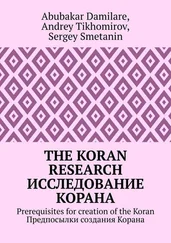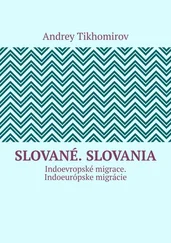Andrey Tikhomirov - The Slavdom. Indo-European Migrations
Здесь есть возможность читать онлайн «Andrey Tikhomirov - The Slavdom. Indo-European Migrations» — ознакомительный отрывок электронной книги совершенно бесплатно, а после прочтения отрывка купить полную версию. В некоторых случаях можно слушать аудио, скачать через торрент в формате fb2 и присутствует краткое содержание. ISBN: , Жанр: Языкознание, История, на английском языке. Описание произведения, (предисловие) а так же отзывы посетителей доступны на портале библиотеки ЛибКат.
- Название:The Slavdom. Indo-European Migrations
- Автор:
- Жанр:
- Год:неизвестен
- ISBN:9785449827043
- Рейтинг книги:4 / 5. Голосов: 1
-
Избранное:Добавить в избранное
- Отзывы:
-
Ваша оценка:
- 80
- 1
- 2
- 3
- 4
- 5
The Slavdom. Indo-European Migrations: краткое содержание, описание и аннотация
Предлагаем к чтению аннотацию, описание, краткое содержание или предисловие (зависит от того, что написал сам автор книги «The Slavdom. Indo-European Migrations»). Если вы не нашли необходимую информацию о книге — напишите в комментариях, мы постараемся отыскать её.
The Slavdom. Indo-European Migrations — читать онлайн ознакомительный отрывок
Ниже представлен текст книги, разбитый по страницам. Система сохранения места последней прочитанной страницы, позволяет с удобством читать онлайн бесплатно книгу «The Slavdom. Indo-European Migrations», без необходимости каждый раз заново искать на чём Вы остановились. Поставьте закладку, и сможете в любой момент перейти на страницу, на которой закончили чтение.
Интервал:
Закладка:
The Slavdom
Indo-European Migrations
Andrey Tikhomirov
© Andrey Tikhomirov, 2020
ISBN 978-5-4498-2704-3
Created with Ridero smart publishing system
The formation of the Slavic peoples
Slavic peoples are based on Slavic languages that belong to the Indo-European language family. Modern Slavs are divided into 3 groups: eastern, southern and western. Belorussians, Russians and Ukrainians belong to the east, Bulgarians, Bosnians, Macedonians, Serbs, Slovenes, Croats and Montenegrins to the south, Kashubians (the ethnic group of Poles that inhabit part of Polish Pomerania – Kashubia), Luzhans, Poles, Slovaks and Czechs. Now these are states in which the majority of the above Slavic peoples are: Belarus, Russia, Ukraine, Bulgaria, Bosnia and Herzegovina, Northern Macedonia, Serbia, Slovenia, Croatia, Montenegro, Poland, Slovakia and the Czech Republic. Luzhichans (Lusatian Serbs, Sorbians, Vendians) live in eastern Germany.
Slavic peoples are currently distributed in large areas of Eastern and Central Europe, the Balkan Peninsula, Siberia and the Far East. The territory of their distribution throughout history has changed significantly. This is especially true for Russians. In some areas of Europe, Slavic peoples assimilated and disappeared. So it was, for example, on the territory of eastern Germany, the modern toponymy of which testifies to the ancient Slavic population of Brandenburg, Mecklenburg, Saxony and other neighboring regions. Back in the 18th century. Slavic speech was preserved on the Elbe (Slavic Laba) in the Lyukhov district on the River Yetz. The texts of the late 17th – early 18th centuries allow us to judge the Labab language.
Slavic languages are related to other Indo-European languages by the most ancient korneslov and formative. Slavic languages are especially close to the group of Baltic (Baltic) languages, even a special Slavic-Baltic community (2—1 millennia BC) is distinguished. In even more ancient times, Slavic languages (4—3 millennia BC) were most likely closely associated with Iranian languages. In the 1st millennium A.D. Slavic languages entered into various ties with the Germanic languages, as well as with the Greek language.
Of the non-Indo-European languages, the relations of the Slavs with the Ugro-Finns and Turkic peoples were especially significant, which was reflected in the vocabulary of the Slavic languages, especially Russian.
One of the most ancient pre-Slavic cultures is Ludwick, located along the Vistula and Oder. Findings and artifacts of the Lugice culture extend to the coast of the Baltic Sea, in the south they reach the upper Vistula and Danube, in the west – the middle reaches of the Elbe, and in the east – to the Bug and upper Pripyat. The earliest monuments of Lugansk culture date back to the Bronze Age, back to the end of the second millennium BC. However, most of the Luga settlements date back to the middle of the 1st millennium BC. Among them, the ancient village located on the shores of Lake Biskupinsky near the Polish city of Poznan is the most well-studied. The remains of wooden buildings due to soil moisture are well preserved. The village was fenced with a powerful defensive wall, built of three rows of wooden log cabins, filled inside with clay, earth and stones. In the village, eight parallel cobbled streets were opened, along which there were long houses. The arrangement of houses in the form of huge collective dwellings, divided into rooms, indicates that tribal communities lived in them, within which there was already a clear division into families, but families were not yet separated from the clan. Among the finds are many ceramics from various vessels.
Luzhitsky tribes were engaged in agriculture. As a result of excavations, the remains of wooden plow, horny hoes on a wooden handle, iron sickles and simple stone grain grinders were found. Carbonized rye, wheat, barley and pea grains were also found in the Biskupinsky settlement in Poland. Of the fibrous plants, flax was known. Findings made in these houses indicate the absence of any noticeable property differentiation of their inhabitants. The same conclusion should be drawn from the consideration of funerary monuments of this culture, which differ in uniformity and in this respect are completely different, for example, from the barrow cemeteries of Scythia, where there is a sharp property differentiation of the buried. The tribes of Luga culture burned their dead, followed by the burial of urns with ashes on the “funeral field” – a rite very characteristic of the ancient Slavs.
In the I millennium BC among the tribes of Luga culture, iron completely displaces stone, and then bronze, from which only jewelry began to be made. In the 7—6 centuries. BC. The metallurgy of iron spread among the tribes of Luga culture, which was mined by the raw-iron method from local bog ores. Tribes of the Luga culture made various dishes from clay (often covering its surface with glaze), figures of animals and birds, children’s toys, etc.
In the economy of the Luga population, a significant place was also occupied by domestic cattle breeding. There are many bones of domestic animals in the settlements, among them especially cattle bones. The burials of the Luzick culture are known. The deceased were burnt, and the remains of the incineration were enclosed in clay pots, covered with a crock and put into holes. Such pots with mortal remains are called urns. A small number of things were placed near the urns and vessels were placed, apparently with food. Such burial grounds are called “burial fields”, or “fields of burial urns”. The burial rite in urns later became widespread among the Slavs and non-Slavic tribes of Eastern Europe in the first half of the 1st millennium A.D. e.
Related to Luga’s culture was another Proto-Slavic culture – the Black Forest culture, which occupied the interfluve of the Middle Dnieper and the Upper Bug and was named after the Black Forest hillfort in the Ingulse basin, the right tributary of the Dnieper. In the settlements of this culture dating back to the early Iron Age, there are many horny and bone hoes, tools for processing leather, bone arrowheads, darts, psalms from fishing rods and ceramics. Much material of the Black Forest culture was collected on the Subbotinsky settlement. The materials of this settlement testify to the wide development of craft production. In addition to crafts made of bone and ceramics, more than two hundred fragments of foundry molds were found, which served to cast jewelry and Celts, iron things. The Black Forest culture is characterized by a large number of burial grounds of two types – mounds and barrows. Burials, as well as a number of other elements of culture, are close to the monuments of Luzitsky culture.
Milograd culture, prevalent in southern Belarus, mainly along the right bank of the Dnieper, is another Proto-Slavic culture. On the hillforts of this culture, square at the base of the dwellings are slightly deepened into the soil. The population knew the processing of iron and copper. The economy of Milograd residents is well known from excavations. The basis of it was agriculture and cattle breeding. Along with this, fishing and hunting were of auxiliary importance.
Lomonosov M.V. writes in his book “Ancient Russian History” (1754—1758), the book MV Lomonosov, Selected Prose, comp., foreword. and comment V.A. Dmitrieva, 2nd ed., Moscow: Sov. Russia, 1986, p. 217—219: “Chapter 5 ABOUT THE CONJECTIONS AND CASES OF SLAVIC
The oldest of all the Slavs, according to the news of ancient writers, should be revered from Asia to Europe. What happened in two ways, water and dry, from the above is not difficult to see. For Venets from Troy with Antenor sailed the Archipelago, the Mediterranean and the Adriatic Sea. And it is very likely that after this, for different times and occasions, many of their homogeneous people from Paflagonia on the aforementioned path or along the Black Sea and up the Danube to them and in their neighborhood went to live. This is confirmed, firstly, by the fact that Venets spread very widely along the northern and eastern shores of the Adriatic Gulf and along the lands lying on the Danube; the second, that Paflagonia after that from time to time diminished and, finally, did not rely between the main lands in Asia, for Ptolemy (Geogr., book 5, ch. 3.) is already revered as a small part of Galatia.
Читать дальшеИнтервал:
Закладка:
Похожие книги на «The Slavdom. Indo-European Migrations»
Представляем Вашему вниманию похожие книги на «The Slavdom. Indo-European Migrations» списком для выбора. Мы отобрали схожую по названию и смыслу литературу в надежде предоставить читателям больше вариантов отыскать новые, интересные, ещё непрочитанные произведения.
Обсуждение, отзывы о книге «The Slavdom. Indo-European Migrations» и просто собственные мнения читателей. Оставьте ваши комментарии, напишите, что Вы думаете о произведении, его смысле или главных героях. Укажите что конкретно понравилось, а что нет, и почему Вы так считаете.












